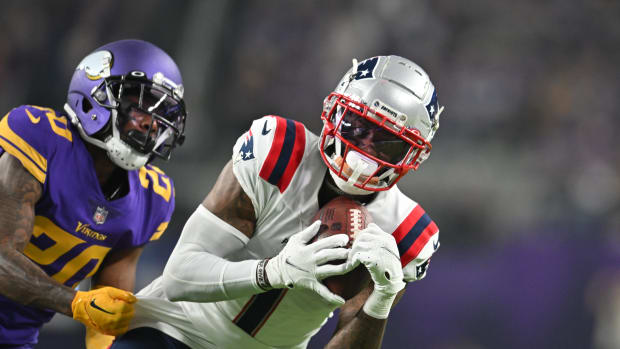
Hurting Their Chances
Poor Cleveland. Even when the Browns win (and they won big on Sunday, 31-10 over the hated Steelers), they seem to lose.
The Browns won their second straight game Sunday to improve to 3-2. And with the Jaguars (0-6), Raiders (0-5) and Buccaneers (1-5) up before a Nov. 6 showdown with the AFC North-leading Bengals, things are looking up.
But to keep ascending, the Browns will have to overcome some major injuries: defensive end Armonty Bryant (right knee) and center Alex Mack (broken fibula). Both could be lost for the season.
There’s no question that losing Mack, a two-time Pro Bowler and second-team All-Pro last season, is a huge blow. The Browns know exactly how important he is. Last offseason, general manager Ray Farmer let the market dictate Mack’s worth by placing the transition tag on him. The Jaguars offered Mack a five-year, $42-million ($8.4 million average) contract that made him the highest paid center in the league, and the Browns (who were already paying a premium to another offensive lineman, left tackle Joe Thomas at $11.5 million per season through 2018) didn’t blink at matching it.
Why was Mack worth that kind of money?
For starters, he has been the definition of reliable. Since Cleveland took him 21st overall in 2009, Mack has started all 85 games and played 5,279 snaps before Sunday’s injury late in the second quarter on Sunday. When Mack left the game, it marked the first time all season the Browns didn’t have all five starting offensive linemen in the lineup at the same time, a streak of 300 straight snaps.
He’s one of the smartest offensive linemen in the league. Since his first NFL game, Mack has been in charge of setting protections and run-blocking assignments. As far as pre-snap adjustments, Mack has had as much on his plate as any of Cleveland’s quarterbacks during his tenure. And considering the Browns’ history under center, that’s a very good thing.
Physically, Mack’s play has been in line with the league’s top centers, right up there with Nick Mangold (Jets) and Jason Kelce (Eagles). There are three factors that separate that trio from the rest:
Is This Real, Cleveland?
Peter King leads off his MMQB column with the Browns' convincing win over the hated Steelers. FULL STORY
1) They are unbelievably quick going from the snap to their first move, whether that is in pass protection or run blocking. Few appreciate how difficult that is: You’re setting assignments, looking at a defender who is often about three inches away, and then starting the play by successfully getting the ball to the quarterback. Not everyone can do that. And certainly not with the efficiency of the best in the game.
2) All three players, especially Mack, excel at making an initial block in the run game, and then getting to the second level where the linebackers reside. When you’re running a pure zone-blocking scheme like the Browns are under offensive coordinator Kyle Shanahan, the center is responsible for the key blocks on inside zone runs. They must execute a double team at the point of attack with one of the guards, precisely judge when that defender is handled to the point that they can move on to the second level, and then pick off the backside linebacker, who is difference between a small gain and a big play. If a center can take care of that linebacker on a consistent basis, the cutback lane will be wide open. Watch any Browns game and you will constantly see Mack five-to-seven yards down the field. He gets to the second level as fast as any center in the game, which is why he is one of the top run-blockers in the NFL.
3) Finally, the best centers excel at adjusting on the fly in pass protection. They are often responsible for picking up a late pass-rusher, so that means effectively passing off the first rusher to a teammate and then picking up the late rusher. Along with the physical challenge, the center needs to process things quickly. Average centers can screw up both blocks. Players like Mack get both blocks right most of the time.
Can the Browns continue their winning ways without Mack? It’s going to be difficult, but yes, they can. One thing working in their favor is the zone-blocking scheme Shanahan has used in his first year in Cleveland. It doesn’t quite have the same degree of difficulty of schemes the Browns ran in previous years. It’s pretty much a run-the-play-that’s-called offense. There aren’t many (if any) audibles from the quarterback that linemen need to adjust to. And unlike many schemes, it doesn’t appear that the Browns have to identify the middle linebacker in order to set the protection.
• WATCH: Could Brian Hoyer be Cleveland's QB of the future?
This should make the transition to John Greco, who moved from right guard to center against the Steelers, a bit smoother. It will also help that Greco is a similar size (6-4, tall for a center) to Mack and seems to play smart. Greco was a very good guard, so the effect will likely trickle down to right guard, where former Seahawks starter Paul McQuistan filled in on Sunday. McQuistan is a veteran who has experience all over the line; he struggled at tackle in Seattle, but he’s an average guard at best. Ultimately, the Browns are downgrading at two spots.
Injuries happen to every team, especially on the offensive line, and teams have to adjust. The Browns will have to figure out what they can and can’t do without Mack, and adjust accordingly. There’s no question that losing one of the best centers in the game is going to be painful, but the Browns can keep winning. They might not have as many big plays in the run game, and quarterback Brian Hoyer might take a few more shots, but that’s football.
[widget widget_name="SI Newsletter Widget”]





































